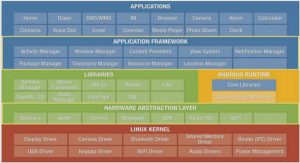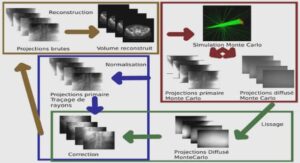L’ézétimibe augmente l’expression intestinale du gène du récepteur LDL chez des hommes dyslipidémiques et insulino-résistants
Materials and methods
Study subjects
A total of 25 unrelated dyslipidaemic men with IR who were from the Quebec City area were recruited between December 2013 and January 2015 by the Institute of Nutrition and Functional Food of Laval University. To be included in the study, participants were required to be aged 18-65 years and to have fasting plasma triglyceride levels ≥1.3 mmol/L (114 mg/dL) and <7.0 mmol/L and fasting insulin levels ≥90 pmol/L. Fasting triglyceride and insulin levels were measured at 2 different screening visits. The average triglyceride and insulin concentrations had to meet the above criteria. Participants also had to have a stable body weight for >3 months prior to screening, a body mass index (BMI) ≥25 kg/m2 and a waist circumference ≥ 94 cm. Only men were included in the present study in order to limit the known confounding effects of the menstrual cycle and female hormones on lipid metabolism.13,14 Exclusion criteria included smoking (>1 cigarette/day), illicit drug consumption, alcoholism, extreme dyslipidaemia (e.g., familial hypercholesterolaemia), type 2 diabetes, a history of cardiovascular disease or cancer, acute hepatic or renal disease (aspartate transaminase/alanine transaminase >1.5 x the upper limit of normal (ULN), creatinine levels >176 μmol/L, and creatine phosphokinase levels >2 x the ULN), HIV infection, uncontrolled high blood pressure (>160/110 mmHg) or any other condition that could interfere with participation in the study. Lipid-lowering medications were stopped 3 weeks prior to the first screening visit and were withheld for the duration of the study. Use of antidepressants, antihypertensive drugs or levothyroxine was allowed only if doses had been stable for >3 months prior to the first screening visit. Any other drugs, dietary supplements or natural health products were stopped prior to the study and were withheld for the duration of the study. The Laval University Medical Center ethics review committee approved the research protocol. Written consent was obtained from all participants. This trial was registered at clinicaltrials.gov (NCT01849068).
Study design
This study was a double-blind, randomized, crossover, placebo-controlled trial. At baseline (week 0), eligible participants were assigned to either the ezetimibe-placebo or the placebo-ezetimibe treatment sequence by a computer-assisted house program, based on their rank of inclusion in the study. Participants assigned to the ezetimibe-placebo sequence (n=13) first received 10 mg/day ezetimibe for 12 weeks and then received placebo treatment for 12 weeks without a washout period. Participants assigned to the placebo-ezetimibe sequence (n=12) received the two treatments in the reverse order. Participants were instructed to take 1 capsule with their morning meal and to maintain their usual physical activity. Alcohol consumption was limited to ≤1 serving/d during the study. During each treatment phase, the research coordinators (J.P.D.C. and M.C.L.) monitored study medication compliance by contacting the participants every 3 weeks (weeks 3, 6, and 9 of each treatment). Compliance with ezetimibe and placebo treatment was assessed by pill counting at the end of each treatment phase. Fasting blood samples were collected at the 2 screening visits, at baseline (week
0) and at the end of each treatment (weeks 12 and 24). Duodenal biopsy samples were obtained at the end of each treatment (weeks 12 and 24). Alcohol consumption and high-intensity physical activity were prohibited 48 hours prior to the duodenal biopsies. Participants and coordinators were blinded until the final statistical analyses were conducted.
Dietary assessment and counseling
Selected participants had to complete a validated web-based, self-administered food frequency questionnaire15 before the beginning of the intervention. The food frequency questionnaire was designed to evaluate dietary intake during the preceding 4 weeks. Based on the results of the food frequency questionnaire, participants received personalized advice from a registered nutritionist (J.P.D.C.) regarding consumption of a standard heart-healthy diet with reduced sugars and trans and saturated fats. Participants had a 2-week run-in period to familiarize themselves with the dietary recommendations (weeks -2 to 0). During the intervention, the dietary recommendations were reinforced every 3 weeks. food frequency questionnaires were also administered at weeks 12 and 24 to assess participant diets during each treatment phase.
Fasting plasma lipoprotein, glucose and insulin concentrations
Twelve-hour fasting venous blood samples were obtained from an antecubital vein. Serum was separated from blood cells by centrifugation at 1100 g (2200 rpm) for 10 minutes at 18°C. Serum cholesterol and TG concentrations were determined with a Roche/Hitachi MODULAR analyzer (Roche Diagnostics, Indianapolis, IN, USA) with proper reagents. Blood glucose levels were measured by colorimetry and insulin concentrations by electrochemiluminescence (Roche Diagnostics).
Intestinal biopsies
Biopsy samples were collected from the second portion of the duodenum during gastroduodenoscopy. Three samples (3 x 3 mm) were collected using single-use biopsy forceps and were immediately flash frozen in liquid nitrogen and stored at -80°C before RNA extraction.
Total RNA extraction, RNA quantification, and quantitative real-time PCR
The intestinal biopsy tissue samples were homogenized in 1 mL of Qiazol and were extracted using an RNeasy kit (Qiagen, Hilden, Germany). The tissue samples were also treated with an RNase-free DNase set to eliminate any contaminating DNA. Total RNA was then eluted into 100 µL of RNase-free H2O and stored at -80°C. RNA quantification and quantitative real-time PCR were performed as described previously.16 Sequence primers and gene descriptions are available in Table S1.
Sample size estimation
The power calculation was performed based on the expected difference in LDLR mRNA expression after treatment with ezetimibe vs placebo using a conservative approach. It was assumed that the standard deviation of the difference in mRNA levels between each treatment phase was as important as the mean treatment effect. Power calculations indicated that a total of 20 participants entering this study with a desired power of 80% would allow us to detect a treatment difference at a two-sided value of 5% if the true difference between the placebo and ezetimibe treatments was 0.935 times the within-patient standard deviation. Therefore, 25 participants were selected and randomized to account for a 20% drop-out rate.
Statistical analyses
Statistical analyses were performed using mixed models with SAS software, v9.3.0 (SAS Institute, Cary, NC, USA). In the mixed models, treatments and sequences were treated as fixed effects. Participants were treated as a random effect. mRNA gene expression and lipid risk factors were considered the dependent variables, and the treatment (ezetimibe vs placebo) was considered the independent variable in the mixed models. The covariance structure was adjusted for each dependent variable to maximize the fit of the model to the data. Treatment sequence and specific screening values (when available) were included in all models as covariables. Specific screening values were used in the models in place of treatment-specific baseline values because of the absence of a washout period between the two treatments. Statistical models for mRNA gene expression and lipid levels were adjusted for anthropometric characteristics and dietary factors that differed significantly between the two treatments. Only significant covariables were retained in the final mixed models. The normality of the models was assessed by the distribution of the scaled residual values. Because of the number of patients (n<30), a Wilcoxon non-parametric signed-rank test was also performed on the main outcomes. As part of an exploratory approach, a non-parametric Spearman’s rank correlation test was performed to evaluate the associations among key intestinal genes involved in cholesterol metabolism with respect to changes in mRNA expression levels after treatment with ezetimibe vs placebo. P values <.05 were taken to indicate statistical significance.
Results
Characteristics of the subjects
A total of 74 men were screened, of whom 25 met the inclusion criteria and were randomized. During the intervention, five participants withdrew from the study for personal reasons (lack of time, n = 1; alcohol consumption limit considered too strict, n = 2; and no longer willing to undergo gastroduodenoscopy, n = 2). In all, 20 men completed the study. Participant demographic, anthropometric and fasting biochemical characteristics are presented in Table 1. The mean age, BMI and waist circumference of the participants were 39.4 ± 10.8 y, 34.4 ± 3.9 kg/m2 and 113.9 ± 10.8 cm, respectively. Participants with IR presented with an elevated fasting insulin level of 138 ± 30 ρmol/L and a homeostasis model assessment of insulin resistance (HOMA-IR) index of 4.63 ± 0.95. Subjects also presented with the typical findings of atherogenic dyslipidaemia, including increased plasma triglyceride levels (2.25 ± 0.67 mmol/L) and low HDL cholesterol levels (1.01 ± 0.24 mmol/L).
During the intervention, compliance with treatment was very high and was similar between the two phases (placebo: 97.2 ± 4.6%; ezetimibe: 96.7 ± 4.0%; P = .7). All participants had compliance scores >80% during each phase.
Dietary intake was similar between the two treatment phases, with the exception of lipid and saturated fatty acid (SFA) intake (Table 2). Lipid intake was slightly but significantly higher during treatment with ezetimibe ( = +1.6% of calories; P = .04), which was due to an increase in SFA intake ( = +0.9% of calories; P = .03).
Table 3 shows the anthropometric and biochemical characteristics of the participants at the end of each treatment. LDL cholesterol levels were significantly reduced after treatment with ezetimibe compared to placebo ( = -23.3%; P < .0001). As shown in Figure 1, LDL cholesterol levels decreased in 19 of 20 participants. Total cholesterol levels and the total cholesterol/HDL cholesterol
ratio also decreased after treatment with ezetimibe ( = -14.5% and = -15.8%, P < .0001, respectively), while ezetimibe had no significant impact on HDL cholesterol levels. Twelve of 20 participants had lower triglyceride levels with ezetimibe treatment, but the mean reduction did not reach statistical significance ( = -11.9%; P = .09). Fasting glucose levels were significantly higher following treatment with ezetimibe vs placebo ( = +2.9%; P = .03), but insulin levels and the HOMA-IR remained unchanged.
Intestinal mRNA expression
Table 4 presents the changes in intestinal mRNA expression of various genes involved in cholesterol and lipoprotein metabolism. Treatment with ezetimibe significantly upregulated intestinal expression of the LDLR ( = +16.2%; P = .01); however, the expression of PCSK9 and other genes involved in lipoprotein assembly and transport did not change after ezetimibe therapy. Of the genes involved in cholesterol metabolism and transport, HMG-CoAR ( = +14.0%; P = .04) and acetyl-Coenzyme A acetyltransferase 2 (ACAT-2) ( = +12.5%; P = .03) were significantly upregulated by ezetimibe. Intestinal NPC1L1, ABCG5 and ABCG8 mRNA levels were not changed. Ezetimibe had no impact on the intestinal mRNA expression of genes that are involved in fatty acid metabolism and transport, such as acyl-CoA synthetase 1 (ACS-1), fatty acid transport protein 4 (FATP-4), and fatty acid binding protein 2 (FABP-2). No significant changes were observed in the expression of genes involved in triglyceride synthesis, but a slight down-regulation in mannosyl (alpha-1,6-)-glycoprotein beta-1,2-N-acetylglucosaminyltransferase (MGAT-2) expression ( = -5.8%; P = .06) was noted. This decrease reached statistical significance only in the non-parametric analysis (p value for Wilcoxon signed-rank test = .03). Hepatocyte nuclear factor-4α (HNF-4α) mRNA levels were significantly reduced by ezetimibe ( = -9.6%; P = .007).


